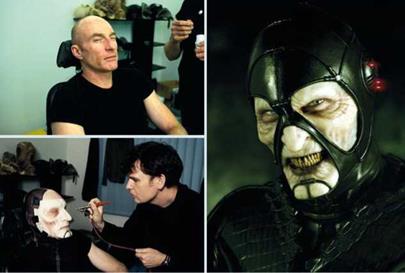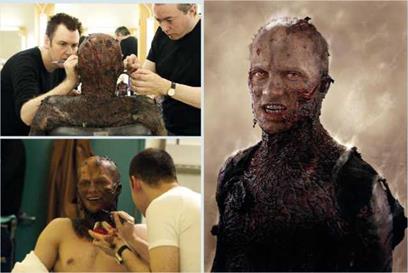![]()
![]()
![]()
This chapter describes the steps needed to break down a sculpture into the parts needed for mold making.
You learned about the types and importance of release agents and sealers. Resculpting for multipiece makeup was illustrated.
The purpose and placement of keys, flashing, and cutting edges was described.
You were shown how to construct a sturdy clay retaining wall around your sculpture.
You were told about different types of molds and mold materials and were given descriptions of them.
![]()
You were told about fillers.
■ Understanding silicone (continued)
■ Coloring silicone intrinsically (internally) for translucence
■ Gel-filled appliances, filling the mold, and removing the appliance
■ Foam latex and its properties
■ Running foam latex
■ Casting urethane (cold) foam
■ Casting gelatin and foamed gelatin
■ Casting dental acrylic
■ Painting and seaming (cleaning up) appliances and teeth
This chapter describes the methods for creating prosthetics using silicone, foam latex, foam urethane, gelatin, and foamed gelatin and dental acrylic. Rather than make a laundry list of materials needed to cast prosthetic appliances, I will add the list of materials specific to a particular type of appliance, such as foam latex, gelatin, and silicone, for each section.
From creating fantastical creatures for the sci-fi television series Farscape to his plant-wrangling skills for The Little Shop of Horrors, Dave Elsey has demonstrated an extraordinary ability to create memorable characters using makeup and animatronics over the past 20 years. To many, Dave’s resume reads like a cult-film dream list: He created creature effects in Alien 3; worked as a special makeup-effects artist on Hellraiser, Mission: Impossible, MI 2, and Indiana Jones and the Last Crusade; and honed his animatronics skills in the cult classic, The Little Shop of Horrors. He is perhaps most well known by genre fans for his role as the creative supervisor on the sci-fi TV series Farscape, for which he designed and maintained up to 600 different creatures.
![]()
![]()
 For his role as the Creature Shop Supervisor for Star Wars: Episode III, Revenge of the Sith (for which he was nominated for an Academy Award), Dave and his makeup effects team were responsible for bringing to life all the animatronics, prosthetic creatures, and characters seen in the film. Dave was at the forefront of the Creature Shop team responsible for such Episode III creations as the Wookies, the Utapauns, charred Anakin Skywalker, and the twisted Emperor Palpatine.
For his role as the Creature Shop Supervisor for Star Wars: Episode III, Revenge of the Sith (for which he was nominated for an Academy Award), Dave and his makeup effects team were responsible for bringing to life all the animatronics, prosthetic creatures, and characters seen in the film. Dave was at the forefront of the Creature Shop team responsible for such Episode III creations as the Wookies, the Utapauns, charred Anakin Skywalker, and the twisted Emperor Palpatine.
|

|
|
|
Since then Dave has worked on the movie Ghost Rider with Nicholas Cage and collaborated with Richard Taylor of Weta Workshop in New Zealand on an independent film entitled Black Sheep.
Most recently Dave was the co-creature supervisor as well as creating the additional creatures for Spike Jonze’s
Where the Wild Things Are. In 2008 Dave worked in London with makeup effects legend Rick Baker and fellow book contributor John Schoonraad on makeup effects for a remake of the 1941 Lon Chaney, Jr., horror classic The Wolf Man, starring Anthony Hopkins and Benicio Del Toro.
![]()


